
Tom Wood, self portrait, 1970s. © the artist.
by DAVID TRIGG
For Tom Wood (b1951, County Mayo, Ireland), photography is a compulsion. He is out with his camera every day, sometimes on his bike, sometimes on foot, but always taking pictures. This has been his way of life for five decades, currently in the rural landscape around his north Wales home, but most famously in Liverpool where, between 1978 and 2003, he photographed people on the streets, in pubs and clubs, waiting for ferries and, in his most well-known series, riding on the buses of Merseyside. His photographs record the mood of the area during a time of significant social change, although he was only ever interested in getting a good picture. It is fitting, then, that the city’s Walker Art Gallery is hosting the first major retrospective of his work. This is a community for which Wood has a lot of love. And that love is reciprocated, with the locals giving him the affectionate nickname “photie man”.

Tom Wood, Brothers fighting, Vale Park, 1980s. © the artist.
Two boys are having a punch-up in the park, a crowd of women pore over a market stall piled high with shoes, a girl grimaces awkwardly through a cafe window as we see Wood reflected in the glass. Wood’s photographs present an unvarnished view of daily life. Populated by friends, strangers, families, children, mothers, daughters, sisters and couples, his pictures are intimate, informal and often quirky. Above all, they are human and always respectful of their subjects. These are images of the ordinary and yet, somehow, through the eye of Wood’s lens, the quotidian is made extraordinary.
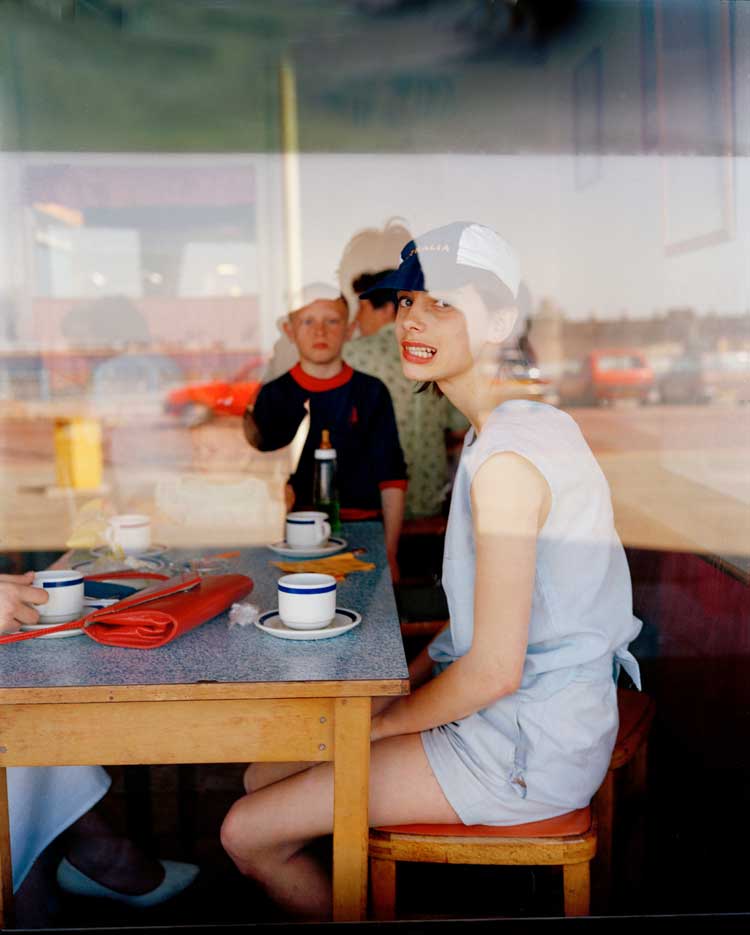
Tom Wood, Grimace girl, 1986. © the artist.
Some scenes of social deprivation in 80s Merseyside are especially gritty. “I’d go into some of these housing estates and six or seven out of 10 men would be unemployed. It seemed such a waste,” he says. “I started doing portraits of these kids hanging around on drugs, or whatever, and some of their parents. It was really tough.” Other pictures capture life at the Cammell Laird shipyard just before it closed down. “I was taking pictures down in the hulls of ships and it was pitch black, so I would just put up the tripod, open the lens and then wander around with a flash gun, not knowing how the photographs would turn out. Some of them just knocked me out.” Wood, now in his 70s, has a child-like wonder for photography and is still genuinely surprised by many of the pictures he has amassed over the decades, some of which he has only recently got round to printing.
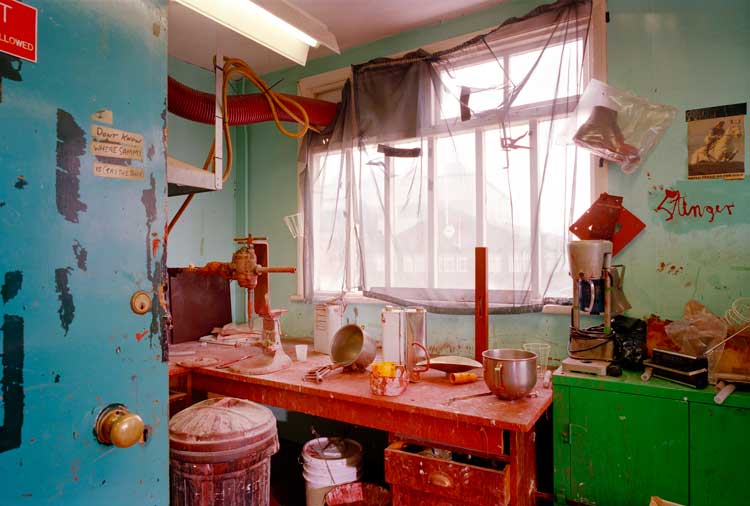
Tom Wood, Cammell Laird series. © the artist.
Wood moved to Oxford with his family as a young boy. His Catholic mother had run away to England to escape the familial fallout over having married his Protestant father, who joined her later, leaving his farm in Ireland to work in the British Leyland car factory in Cowley. Wood’s interest in photography was sparked in his teenage years after discovering a stash of vintage photographs in a local charity shop. “I got really interested in these old photographs,” he says. “There were family albums but mainly postcards. I liked them because they were real photographs, they had a presence about them, so I started buying them.” Wood considers these pictures, many of which are portraits, to be formative; some are included in the Liverpool exhibition, underscoring their importance to his practice. “I learned more about photography from these found photographs than I ever did from the history of photography,” he insists.
After leaving school, Wood worked as a tax officer, before joining his father on the production line. “In the tax office, I would always be doodling complex drawings while on the phone. Then, in the factory, I’d do drawings of the people and machines,” he says. Drawing at work led to painting at home, which, in 1972, took him to art school. It was towards the end of his foundation course at Oxford Polytechnic (now Oxford Brookes University) in 1973 that he was introduced to practical photography. By then he was seriously into painting and had applied to study fine art at Leicester Polytechnic.
-1973.jpg)
Tom Wood, 'ntlemen, (Cowley, Oxford), 1973. © the artist.
“I was given this camera and a roll of film and went out on to the streets,” he says. “I met this middle-aged lady outside the post office and asked if I could take her picture. She pulled open her coat, as if she was flashing me, and by sheer chance there was the crown from the Royal Mail logo on the window behind her, which I hadn’t noticed, and it looked like it was on her head. When I saw the picture, I was just knocked out by it, by that chance element of photography.” That picture, Royal Raincoat (1973), is included in the exhibition, along with another well-known photograph, Ntlemen (1973), a portrait of two young women drinking bottles of cola beneath the remnants of a lavatory sign. The random encounter was recorded on his second ever roll of film and chance has been an essential ingredient of his practice ever since.
Inspired by these early successes, he bought a Rolleicord camera for £30. “I was studying conceptual art in Leicester,” he says, “but what I was seeing on the streets around me seemed more interesting, so I started taking pictures at the weekends.” After graduating, he returned to the car factory, but a job opening in Liverpool as a photographic technician at the art school changed the course of his career. It was on Merseyside that photography became a serious endeavour and where some of his most iconic images were created. “I never wanted to be a successful artist or anything like that, I just wanted to do the work,” he says, remembering those early days in New Brighton, where he and his wife, Lorna, found themselves “adopted” by the local community. He carried his camera everywhere, shooting portraits and candid scenes on the streets that captured the spirit of the area and the character of its inhabitants.
-1990.jpg)
Tom Wood, Finding a pair (colour film), 1990. © the artist.
Wood’s project is not about social photography, or indeed any kind of documentary. Rather, it has always been an exploration of photographic image-making. “I’m not trying to document anything,” he concurs. “When I first met Martin Parr, in 1981, he said: ‘I’m a documentary photographer, if I get a good picture it’s a bonus.’ And I said: ‘Martin, I’m only interested in good pictures, if it’s a document then it’s a bonus.’” Wood has more in common with the visual tradition of the New Objectivity (Neue Sachlichkeit) movement and photographers such as Thomas Struth and Thomas Ruff: “That’s who I identify with, more than street photography,” he says. “I’m like August Sander, playing that game of classification. It’s a completely different sensibility.”
For Wood, a good picture is one that exudes a certain presence. “When I was on the street, I would go to people and tell them that I wanted to make a portrait, not a throwaway thing, but something that was going to work like those vintage postcards.” A lot of it has to do with eye contact and becoming familiar with people, he says. “When I’m photographing on the street, it’s really physical. I’m always moving around, it’s like a dance. I become completely unselfconscious and really get out of myself. I go into this kind of trance.” Another important element is that Wood always saw himself as one of the people he was photographing; there was no voyeurism or exploitation in what he was doing, and his subjects knew it too. “They could tell that I was doing it for the love of it. People embraced me and I embraced them. There was a connection”.
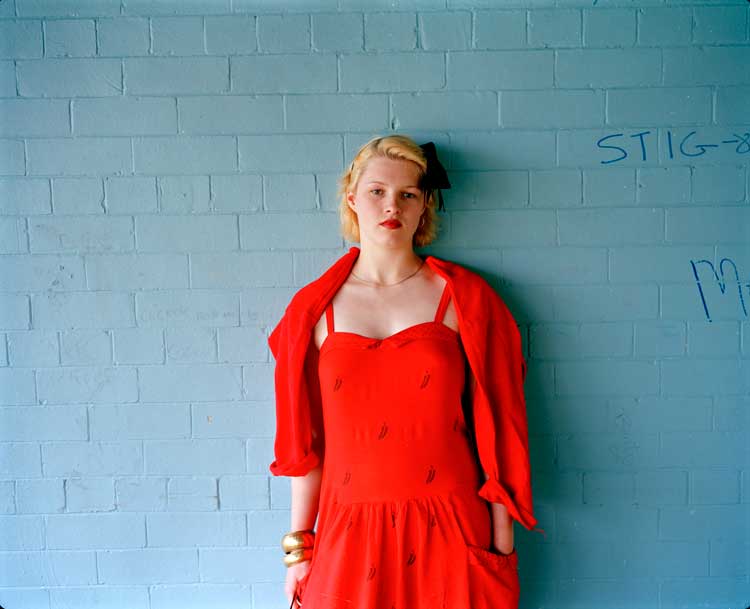
Tom Wood, Rachel, age 17, 1985. © the artist.
Even still, the process of photographing on the street, capturing images in the moment, can be hit and miss. “I might take several pictures of one person and only one would have that little element that lifts it to another level,” he says. A case in point is his famous portrait of a teenage girl in a red dress against a blue wall, Rachel, Age 17 (1985). “I took three or four other pictures of her that day and that was the only one that was kind of transcendent,” he remembers. “I first photographed her when she was 11, then when she was 13, and then there’s another picture of her in the exhibition of her at 32, with her daughter. I did her 50th birthday too,” he says proudly.
Despite claiming to be shy, Wood somehow has the courage to speak to anyone and everyone, often putting people at their ease by introducing himself. “I used to go to the car boot sale on Sunday mornings and I’d get there at 5am so I could be at the gate when the cars were arriving,” he remembers. “I’d say to people, ‘Look, I’m not with social services or trading standards, I’m doing this project and photographing people’, but, even so, some traders were wetting themselves when they saw me with a camera near them. There were these two guys who used to sell pornographic videos from the back of their car, and the one week that I wasn’t there, they were raided by trading standards. When I went back, they grabbed me and pushed me up against the wall and suggested that I was somehow connected. Luckily, BBC North West had done a documentary about Liverpool artists and I was one of them, so I told them I’d bring the video next week to prove I wasn’t involved. The week after that, one of them said: ‘I really enjoyed that video Tom!’”
,-1989.jpg)
Tom Wood, Untitled (bubblegum), 1989. © the artist.
After a while of consistently being present with his camera at Great Homer Street market, match days at Anfield and on the Merseyside buses, he simply became a part of the scenery. “At a certain point, I became invisible,” he says. “People tolerated me because I was always around.” This was certainly the case at the Chelsea Reach nightclub in New Brighton, which gave rise to one of his most popular photobooks, Looking for Love (1989). The revellers, lovers, snoggers and dancers in these photographs all seem blissfully unaware that Wood’s camera has become a part of their night out. How did he get away with it? “Initially, I was photographing at parties above the club,” he says. “I hate getting stuck talking for too long to certain people at parties, but I found that when I photographed, I could have little chats with lots of people and make eye contact with lots of people, and move around, and get pictures.”
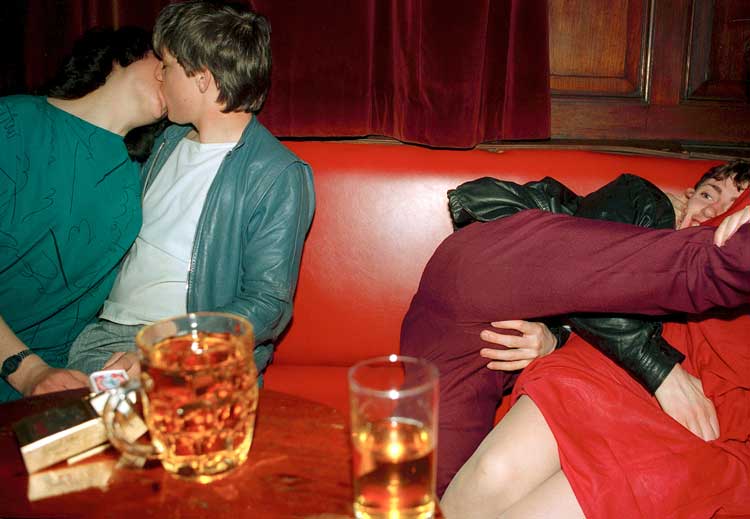
Tom Wood, Double grope leg over, 1985. © the artist.
Although it took him a couple of years to pluck up the courage to take the camera into the club, and at first people were suspicious, he soon won their trust by giving out his photographs and even tacking them to the walls. “People were so made up when I went to the trouble to make a print for them that, when you saw them again, they and their friends would accept you,” he says. Wood spent two years taking photographs in the Chelsea Reach, often visiting the club several nights a week. Sometimes, the people he had met on the streets or on the bus would be out in the club, which made them easier to approach, but there were always some he would pass over. “I could feel that some people didn’t want to be photographed, even if they hadn’t seen me taking pictures, but with other people I felt that I could do it.”
With no driving licence, Wood spent a lot of time on Liverpool’s buses, travelling to and from work, the football, or the market. “I was working at the art school in Liverpool at the time. I spent two years travelling back and forth on the bus and the ferry, so I’d photograph for something to do and try to make interesting pictures,” he says. “Then I got some part-time teaching in Southport, which was quite a long way away and so I’d be photographing all the way there and all the way back again, and on the ferry.”
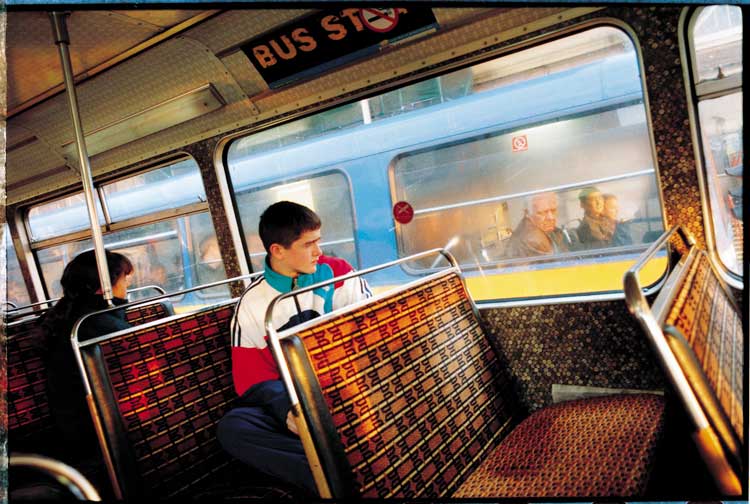
Tom Wood, Lime Street, lives passing by, 1995. © the artist.
Wood continued taking photographs on his bus trips for more than 15 years, amassing an enormous number of images from which his celebrated series All Zones Off Peak was selected in the late 90s. In these images, the bus becomes like a theatre and its passengers performers. Some look straight at us while others stare wistfully out of windows, oblivious to Wood’s lens. Sometimes people are seen on the street through rain-streaked glass, at other times it is Wood who peers in at them from the outside. “How I used to go on buses full of people and photograph I just don’t know, but I did it. I’d go right up to people, no long lenses or anything.”
Wood’s retrospective at the Walker is titled Photie Man, which is the name by which he came to be known around Liverpool. “At first, the kids who pestered me to take their picture would call me David, because the only photographer they knew was David Bailey. So, I would take their pictures just to shut them up. Then I just became known as ‘Photie Man’,” he says. This was, after all, a time before smartphones, when to see someone with a camera was still a novelty. “A guy called Steve Roberts actually wrote a song about me called Over Here Photie Man,” he says. “He sings about the work I made and what it was like living in Liverpool in those days – high unemployment, drugs, the dirty beach. It’s a really catchy song!” Wood often says that he couldn’t have made the majority of his pictures anywhere else, but it is also true that he couldn’t have made them at any time since. He may not have intended it, but they truly are a document of an era.
• Photie Man: 50 Years of Tom Wood is at the Walker Art Gallery, Liverpool, until 7 January 2024.